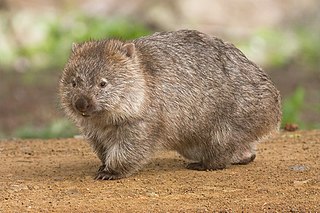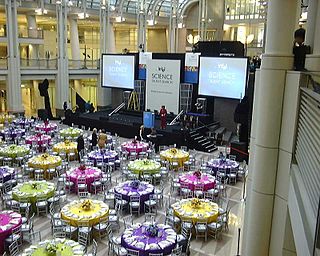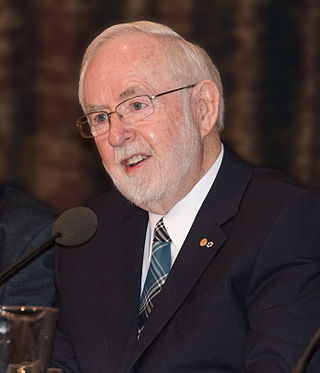Related Research Articles

The Ig Nobel Prize is a satirical prize awarded annually since 1991 to celebrate ten unusual or trivial achievements in scientific research. Its aim is to "honor achievements that first make people laugh, and then make them think." The name of the award is a pun on the Nobel Prize, which it parodies, and on the word "ignoble".

Wombats are short-legged, muscular quadrupedal marsupials of the family Vombatidae that are native to Australia. Living species are about 1 m (40 in) in length with small, stubby tails and weigh between 20 and 35 kg. They are adaptable and habitat tolerant, and are found in forested, mountainous, and heathland areas of southern and eastern Australia, including Tasmania, as well as an isolated patch of about 300 ha in Epping Forest National Park in central Queensland.

The Annals of Improbable Research (AIR) is a bimonthly magazine devoted to scientific humor, in the form of a satirical take on the standard academic journal. AIR, published six times a year since 1995, usually showcases at least one piece of scientific research being done on a strange or unexpected topic, but most of their articles concern real or fictional absurd experiments, such as a comparison of apples and oranges using infrared spectroscopy. Other features include such things as ratings of the cafeterias at scientific institutes, fake classifieds and advertisements for a medical plan called HMO-NO, and a very odd letters page. The magazine is headquartered in Cambridge, Massachusetts.

Yang Chen-Ning or Chen-Ning Yang, also known as C. N. Yang or by the English name Frank Yang, is a Chinese theoretical physicist who made significant contributions to statistical mechanics, integrable systems, gauge theory, and both particle physics and condensed matter physics. He and Tsung-Dao Lee received the 1957 Nobel Prize in Physics for their work on parity non-conservation of weak interaction. The two proposed that the conservation of parity, a physical law observed to hold in all other physical processes, is violated in the so-called weak nuclear reactions, those nuclear processes that result in the emission of beta or alpha particles. Yang is also well known for his collaboration with Robert Mills in developing non-abelian gauge theory, widely known as the Yang–Mills theory.

Sir Michael Victor Berry is a British theoretical physicist. He is the Melville Wills Professor of Physics (Emeritus) at the University of Bristol.
The year 1948 in science and technology involved some significant events, listed below.

The Regeneron Science Talent Search, known for its first 57 years as the Westinghouse Science Talent Search, and then as the Intel Science Talent Search from 1998 through 2016, is a research-based science competition in the United States for high school seniors. It has been referred to as "the nation's oldest and most prestigious" science competition. In his speech at the dinner honoring the 1991 Winners, President George H. W. Bush called the competition the "Super Bowl of science."

Melissa Eve Bronwen Franklin is a Canadian experimental particle physicist and the Mallinckrodt Professor of Physics at Harvard University. In 1992, Franklin became the first woman to receive tenure in the physics department at Harvard University and she served as chair of the department from 2010 to 2014. While working at Fermi National Accelerator Laboratory in Chicago, her team found some of the first evidences for the existence of the top quark. In 1993, Franklin was elected a fellow of the American Physical Society. She is a member of the CDF (Fermilab) and ATLAS (CERN) collaborations.

Roy Jay Glauber was an American theoretical physicist. He was the Mallinckrodt Professor of Physics at Harvard University and Adjunct Professor of Optical Sciences at the University of Arizona. Born in New York City, he was awarded one half of the 2005 Nobel Prize in Physics "for his contribution to the quantum theory of optical coherence", with the other half shared by John L. Hall and Theodor W. Hänsch. In this work, published in 1963, he created a model for photodetection and explained the fundamental characteristics of different types of light, such as laser light and light from light bulbs. His theories are widely used in the field of quantum optics. In statistical physics he pioneered the study of the dynamics of first-order phase transitions, since he first defined and investigated the stochastic dynamics of an Ising model in a paper published in 1963. He served on the National Advisory Board of the Center for Arms Control and Non-Proliferation, the research arms of Council for a Livable World.

John Cromwell Mather is an American astrophysicist, cosmologist and Nobel Prize in Physics laureate for his work on the Cosmic Background Explorer Satellite (COBE) with George Smoot.
Robert A. J. Matthews, is a British physicist and science writer.

Arthur Bruce McDonald, P.Eng is a Canadian astrophysicist. McDonald is the director of the Sudbury Neutrino Observatory Collaboration and held the Gordon and Patricia Gray Chair in Particle Astrophysics at Queen's University in Kingston, Ontario from 2006 to 2013. He was awarded the 2015 Nobel Prize in Physics jointly with Japanese physicist Takaaki Kajita.

Sir Andre Konstantin Geim is a Russian-born Dutch–British physicist working in England in the School of Physics and Astronomy at the University of Manchester.

Harry Jeannot Lipkin, also known as Zvi Lipkin, was an Israeli theoretical physicist specializing in nuclear physics and elementary particle physics. He is a recipient of the prestigious Wigner Medal.

Mu-ming Poo is a Chinese neuroscientist. He is the Paul Licht Distinguished Professor Emeritus at the University of California, Berkeley and the Founding Director of the Shanghai-based Institute of Neuroscience (ION) of the Chinese Academy of Sciences. He was awarded the 2016 Gruber Prize in Neuroscience for his pioneering work on synaptic plasticity. At ION, Poo led a team of scientists that produced the world's first truly cloned primates, a pair of crab-eating macaques called Zhongzhong and Huahua in 2017, using somatic cell nuclear transfer (SCNT).

The Faculty of Science of Eötvös Loránd University was founded in 1949 and it is located in Lágymányos Campus, Újbuda, Budapest, Hungary.
Patricia Priest is a New Zealand public health scientist and epidemiologist who is Professor of Public Health in Medicine at the University of Otago. Throughout the COVID-19 pandemic, Priest served as an advisor to the New Zealand Ministry of Health. She was awarded an Ig Nobel Prize in 2010. As of 2024 Priest is the Acting Pro-Vice-Chancellor of the Division of Health Sciences at the university.
References
- 1 2 3 Gorman, James (5 November 2018). "The Mysteries of Animal Movement". The New York Times. Retrieved 20 April 2020.
- ↑ "David Hu Takes Home Ig Nobel Prize for 'Improbable Research'". Georgia Tech. 15 October 2015. Retrieved 20 April 2020.
- ↑ "Cube-Shaped Poo and Georgia Tech's Second Ig Nobel Prize". Georgia Tech College of Sciences. Georgia Tech. 9 October 2019. Retrieved 20 April 2020.
- ↑ Erlichman, Janelle (24 January 1997). "Area H.S. Has 9 in Prestigious Westinghouse Semifinals". CNS Maryland.
- ↑ Hu, David L. (June 13, 2018). "My Father, the Chemist, Teaches Anatomy". Scientific American.
- ↑ Mallinson, Alissa Mariello (26 Feb 2015). "David Hu". MIT Department of Mechanical Engineering.
- ↑ Frum, Larry (3 October 2019). "The American Institute of Physics Announces 2019 Science Communication Award Winners". American Institute of Physics. Retrieved 20 April 2020.
- ↑ "Senator Jeff Flake's List of Wasteful Government Research Studies". Fox & Friends . 10 May 2016. FOX News. Retrieved 20 April 2020.
- ↑ Hu, David (25 May 2016). "Confessions of a Wasteful Scientist". Scientific American. Retrieved 20 April 2020.
- ↑ "The Ig Nobel Prize Winners". improbable.com. Improbable Research. August 2006. Retrieved 20 April 2020.
- ↑ Yang, Patricia; Hu, David; Pham, Jonathan; Choo, Jerome (19 August 2014). "Duration of urination does not change with body size". Proceedings of the National Academy of Sciences of the United States of America. Retrieved 20 April 2020.
- ↑ Yang, Patricia; Hu, David (18 November 2018). "How do wombats make cubed poo?". Bulletin of the American Physical Society. 63 (13). Retrieved 20 April 2020.
- ↑ "2023 Fellows". APS Fellow Archive. American Physical Society. Retrieved 2023-10-22.